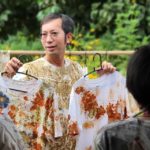Wat Tai Phra Chao Yai Ong Tue

Wat Tai Phra Chao Yai Ong Tue (วัดใต้พระเจ้าใหญ่องค์ตือ) in Ubon Ratchathani is one of the most stunning temples in all of Thailand. Indeed, you would be hard pressed to find any temple, even in the Bangkok area, which matches its dazzling array of Hindu and Buddhist sculptures and murals. In addition to traditional sculptures of the Buddha, you’ll find a seemingly endless cascade of religious iconography, including Yaksha giants, Apsaras, Garudas, Chinthes, Nagas, Erewans, Phra Mae, Guanyin, Phra Phom, and much more. You could spend many hours taking in the splendor and master craftsmanship of all that is on display.
Ubon Ratchathani is about 4 hours from Sakon Nakhon, so visiting Wat Tai Phra Chao Yai Ong Tue isn’t an option for a day trip. But if you are planning a tour of Northeast Thailand, Ubon Ratchathani would be a great place to begin or end your journey, not only because of the dazzling Wat Tai Phra Chao Yai Ong Tue, but also Wat Phra That Nong Bua, whose impressive Indian style Chedi was built in 1956 to celebrate 2500 years of Buddhism. Ubon Ratchathani is located in the southernmost area of Northeast Thailand (Isaan), and flights to and from Bangkok occur daily, just as they do from Sakon Nakhon.
Wat Tai Phra Chao Yai Ong Tue is located on the edge of downtown Ubon Ratchathani, only a few hundred meters from the Mun River (a tributary of the Mekhong), where you can find excellent restaurants and coffeehouses to enjoy. Painted in sea-green, gold, and orange, the temple looks especially stunning in the early morning hours and at dusk, when the play of light creates an often dream like feel to the surroundings. While the temple attracts local tourists on weekends, during the week you can often have Wat Tai Phra Chao Yai Ong Tue nearly entirely to yourself. Being able to explore such an amazing temple away from tourist crowds, makes the experience even more special.
Wat Tai Phra Chao Yai Ong Tue is such a hidden treasure (for now) that you’ll find only one review so far listed on Google Maps, when you would expect well over a thousand. The temple’s name translates to The Temple Beneath the Great God. It is sometimes abbreviated to Wat Tai Thoeng (วัดใต้เทิง). The name is derived from it’s principle Buddha statue (known as Phra Chao Yai or Great/Big God), which is a bronze Buddha sculpture that is among one of five “Great God” statues built during the reign of King Chetthathirat or Borommaracha II (1613-1629). This statue is located in the Ubosot (ordination hall) of the temple, which is adorned with a mixture of Khmer, Vietnamese, and Northeastern Thai art.
- The 1st English Dhamma Talk Project, Sakon Nakhon Thailand - July 8, 2025
- Affirmations in Buddhism & Thailand - June 7, 2025
- Speak Thai Naturally Without the Gymnastics - April 20, 2025




